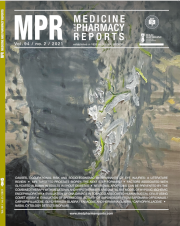EBUS in optimizing non-small cell lung cancer diagnosis and treatment
DOI:
https://doi.org/10.15386/mpr-1725Keywords:
EBUS-TBNA, ROSE, NSCLC, EGFR, ALK, PD-L1Abstract
Background. Endobronchial ultrasound-guided transbronchial needle aspiration (EBUS-TBNA) is a commonly used minimally invasive method for the diagnosis and staging of lung cancer. In order to improve its diagnostic accuracy, rapid on-site cytologic evaluation (ROSE) is being utilized in some institutions. ROSE, performed by a cytopathologist in the examination room, allows the assessment of the adequacy of the collected samples, identifies malignant cells and sometimes establishes diagnosis on the spot, thus improving diagnostic sensitivity. As non-small cell lung carcinomas (NSCLC) require not only pathological subtyping, but also molecular characterization, obtaining the adequate amount of tissue is crucial. Only a limited number of studies have analyzed the suitability of EBUS-TBNA samples for assessment of epidermal growth factor receptor (EGFR), anaplastic lymphoma kinase (ALK) and programmed death-ligand 1 (PD-L1) status.
Aim. We intended to examine the diagnostic yield of ROSE in NSCLC and the results and feasibility of molecular analysis performed on EBUS-TBNA small samples.
Methods. 100 patients with lung tumors and hilar and/or mediastinal lymphadenopathy on CT or PET/CT scans were retrospectively identified over a 3-year period, from a prospectively maintained EBUS-TBNA database. All examinations were accompanied by on-site cytological exam - ROSE, histopathological exam (HPE) and, in the case of NSCLC, molecular testing. After the sampling of the lymph nodes, specimens were Diff-Quik stained and a rapid preliminary diagnosis was established. Immunohistochemistry and mutational testing were performed using cell blocks.
Results. Adenocarcinoma was the most frequent diagnosis in both ROSE (34%) and histopathology (53%). Overall sensitivity and positive predictive value of ROSE in NSCLC, considering HPE the gold standard, were 92.18% and 93.65%, respectively, with a specificity and negative predictive value of 75% and 70.58%, respectively. All samples that were tested for EGFR mutation and ALK rearrangement were adequate for analysis. The adequacy ratio for PD-L1 was 91.66%; 37.5% of patients showed a high PD-L1 expression level, with a tumor proportion score TPS≥50%.
Conclusion. EBUS-TBNA is a valuable method for lung cancer diagnosis. ROSE proved to have a moderate prediction of the final diagnosis in NSCLC. Molecular analysis of EGFR, ALK and PD-L1 can be successfully accomplished on EBUS-TBNA small tissue samples.
Downloads
Published
How to Cite
Issue
Section
License
The authors are required to transfer the copyright of the published paper to the journal. This is done by agreeing to sign the Copyright Assignment Form. Whenever the case, authors are also required to send permissions to reproduce material (such as illustrations) from the copyright holder.

The papers published in the journal are licensed under a Creative Commons Attribution-NonCommercial-NoDerivatives 4.0 International License.

